Bio-Methanization of Sheep Manure and Beet Waste in the Meknes–Fès Region, Morocco: Effects of Pretreatment and Machine Learning Applications for Biochemical Methane Potential Prediction
Abstract
1. Introduction
2. Results and Discussion
2.1. Compositions of the Substrate Samples
2.2. Biochemical Methane Production Potential
2.2.1. Sheep Manure
2.2.2. Beet Waste
2.3. Modeling Biogas Yield Results
3. Materials and Methods
3.1. Sample Collection
3.2. Substrate Characterization
3.3. Pretreatment Methods
3.4. Biochemical Methane Potential Assay
3.5. Exploratory Data Analysis and Predictive Modeling Workflow
4. Conclusions
Author Contributions
Funding
Data Availability Statement
Acknowledgments
Conflicts of Interest
Abbreviation
| BMP | Biochemical Methane Potential |
| LM | Regression |
| RFR | Random Forest Regression |
| GBM | Gradient Boosting Machine |
| Ts | Total Solids |
| Vs | Volatile Solids |
| PP | Physical Pretreatment |
| TP | Thermal Pretreatment |
| PTP | Physical and Thermal Pretreatment |
| AMPTS III | Automatic Methane Potential Testing System |
| EDA | Exploratory Data Analysis |
| SVR | Support Vector Regression |
| XGBoost | Extreme Gradient Boosting |
| HRT | Hydraulic Retention Time |
References
- Surendra, K.C.; Takara, D.; Hashimoto, A.G.; Khanal, S.K. Biogas as a sustainable energy source for developing countries: Opportunities and challenges. Renew. Sustain. Energy Rev. 2014, 31, 846–859. [Google Scholar] [CrossRef]
- Dina Bacovsky Chair IEA, Andrea Rossi Secretary, Bioenergy. Available online: https://www.ieabioenergy.com/wp-content/uploads/2024/06/Annual-Report-2023.pdf (accessed on 10 October 2025).
- Tayibi, S.; Monlau, F.; Marias, F.; Cazaudehore, G.; Fayoud, N.-E.; Oukarroum, A.; Barakat, A. Coupling anaerobic digestion and pyrolysis processes for maximizing energy recovery and soil preservation according to the circular economy concept. J. Environ. Manag. 2021, 279, 111632. [Google Scholar] [CrossRef] [PubMed]
- Koch, K.; Helmreich, B.; Drewes, J.E. Co-digestion of food waste in municipal wastewater treatment plants: Effect of different mixtures on methane yield and hydrolysis rate constant. Appl. Energy 2015, 137, 250–255. [Google Scholar] [CrossRef]
- Gunaseelan, V.N. Anaerobic digestion of biomass for methane production: A review. Biomass Bioenergy 1997, 13, 83–114. [Google Scholar] [CrossRef]
- Amon, T.; Amon, B.; Kryvoruchko, V.; Zollitsch, W.; Mayer, K.; Gruber, L. Biogas production from maize and dairy cattle manure: Influence of biomass composition on methane yield. Agric. Ecosyst. Environ. 2007, 118, 173–182. [Google Scholar] [CrossRef]
- Zhang, H.; Han, L.; Dong, H. An insight to pretreatment, enzyme adsorption and enzymatic hydrolysis of lignocellulosic biomass: Experimental and modeling studies. Renew. Sustain. Energy Rev. 2021, 140, 110758. [Google Scholar] [CrossRef]
- Peng, S.; Guo, L.; Li, Y.; Huang, H.; Peng, J.; Liu, X. Biogas production prediction based on feature selection and ensemble learning. Appl. Sci. 2024, 14, 901. [Google Scholar] [CrossRef]
- Song, C.; Cai, F.; Yang, S.; Wang, L.; Liu, G.; Chen, C. Machine learning-based prediction of methane production from lignocellulosic wastes. Bioresour. Technol. 2024, 393, 129953. [Google Scholar] [CrossRef] [PubMed]
- Cu, T.T.T.; Nguyen, T.X.; Triolo, J.M.; Pedersen, L.; Le, V.D.; Le, P.D.; Sommer, S.G. Biogas Production from Vietnamese Animal Manure, Plant Residues and Organic Waste: Influence of Biomass Composition on Methane Yield. Asian-Australas. J. Anim. Sci. 2014, 28, 280–289. [Google Scholar] [CrossRef] [PubMed]
- Kim, S.; Lee, C.; Kim, J.; Kim, J.Y. Feasibility of thermal hydrolysis pretreatment to reduce hydraulic retention time of anaerobic digestion of cattle manure. Bioresour. Technol. 2023, 384, 129308. [Google Scholar] [CrossRef] [PubMed]
- Khan, M.U.; Ahring, B.K. Pretreatment of digested manure fibers at high temperature (185 °C) with lime added enhances methane production. Biocatal. Agric. Biotechnol. 2022, 44, 102460. [Google Scholar] [CrossRef]
- Nyang’aU, J.O.; El Mahdi, J.; Møller, H.B.; Sørensen, P. Unlocking higher methane yields and digestate nitrogen availability in soil through thermal treatment of feedstocks in a two-step anaerobic digestion. Chem. Biol. Technol. Agric. 2024, 11, 186. [Google Scholar] [CrossRef]
- Peguero, D.A.; Gold, M.; Velasquez, L.; Niu, M.; Zurbrügg, C.; Mathys, A. Physical pretreatment of three biowastes to improve black soldier fly larvae bioconversion efficiency. Waste Manag. 2024, 178, 280–291. [Google Scholar] [CrossRef] [PubMed]
- Ziemiński, K.; Kowalska-Wentel, M. Effect of Different Sugar Beet Waste Pulp Pretreatments on Biogas Production Efficiency. Appl. Biochem. Biotechnol. 2016, 181, 1211–1227. [Google Scholar] [CrossRef] [PubMed]
- Carrere, H.; Dumas, C.; Battimelli, A.; Batstone, D.J.; Delgenès, J.P.; Steyer, J.P.; Ferrer, I. Pretreatment methods to improve sludge anaerobic degradability: A review. J. Hazard. Mater. 2010, 183, 1–15. [Google Scholar] [CrossRef] [PubMed]
- Obileke, K.C.; Tangwe, S.; Makaka, G.; Mukumba, P. Comparison of prediction of biogas yield in a batch-mode underground fixed-dome digester with cow dung. Biomass Convers. Biorefinery 2023, 14, 26427–26442. [Google Scholar] [CrossRef]
- Rosi, L.; Cenni, M.; Ciuffi, B.; Casini, D.; Rizzo, A.M.; Chiaramonti, D. Enhancing biogas production in anaerobic digestion by the addition of oxidized and non-oxidized biochars. Biomass Convers. Biorefinery 2022, 14, 5457–5468. [Google Scholar] [CrossRef]
- Deval, S.; Mamta, T.; Kundeshwar, P.; Dikshit, A.K. Machine learning based prediction of biogas generation from municipal solid waste: A data-driven approach. Renew. Energy. 2024, 213, 118–127. [Google Scholar] [CrossRef]
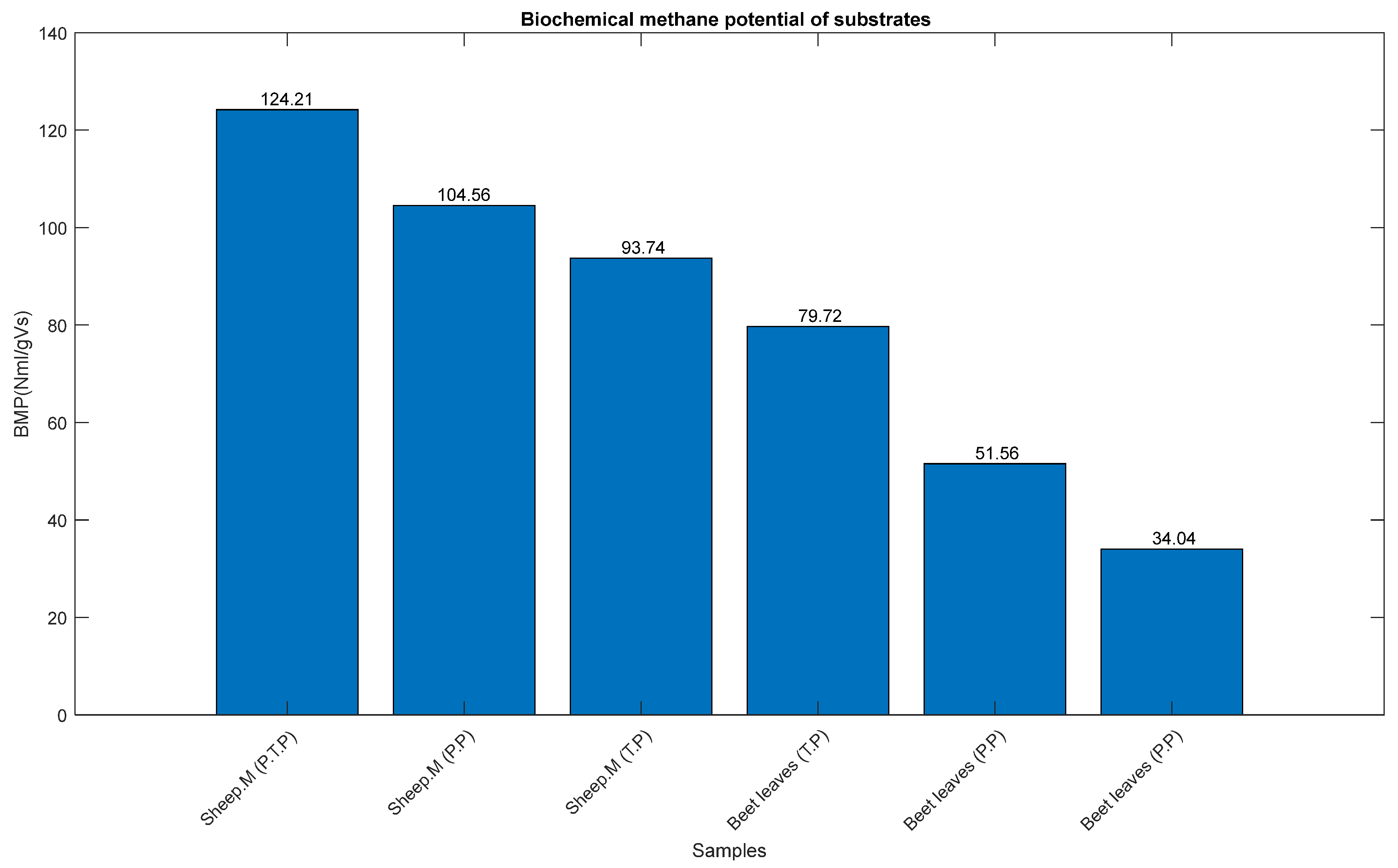
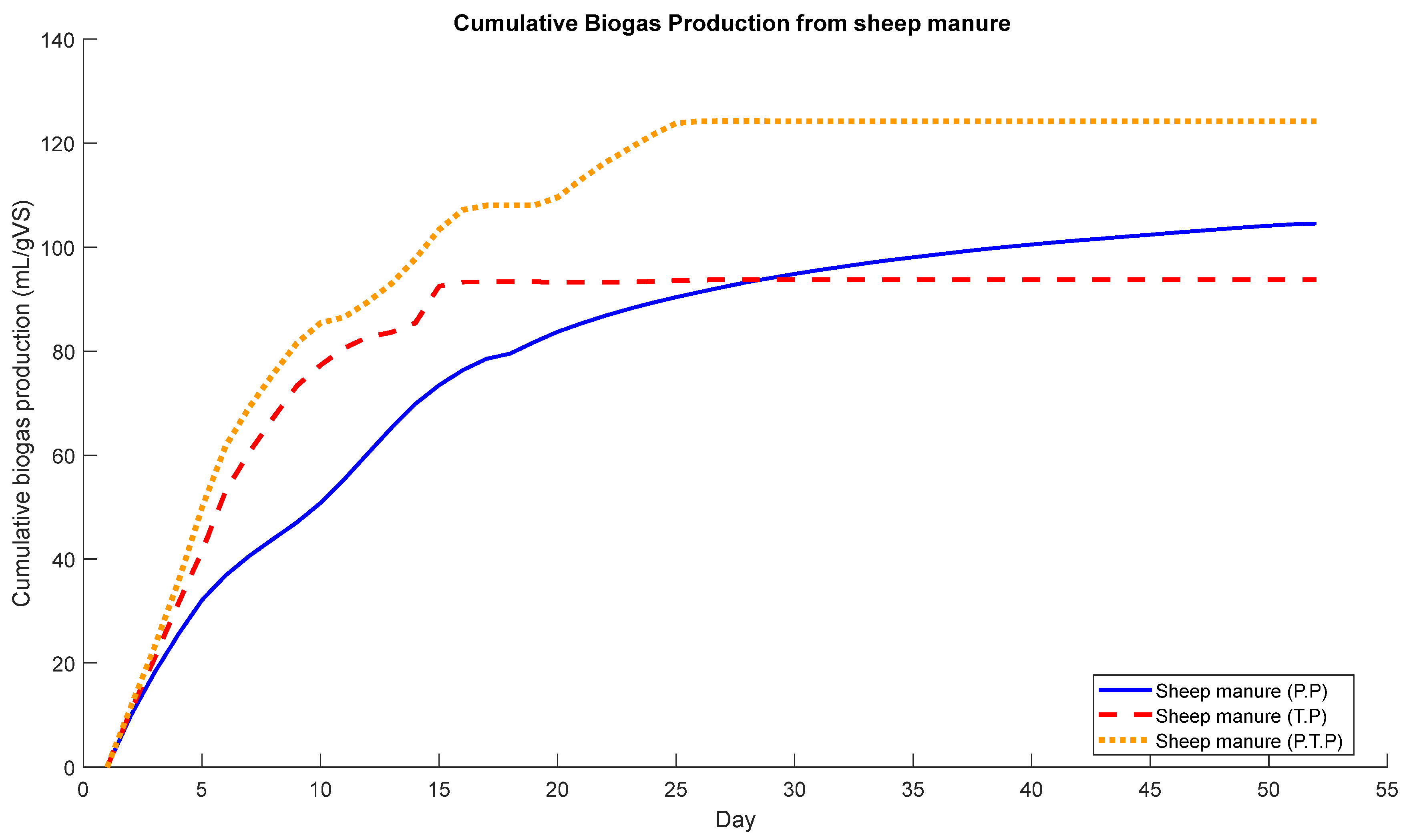
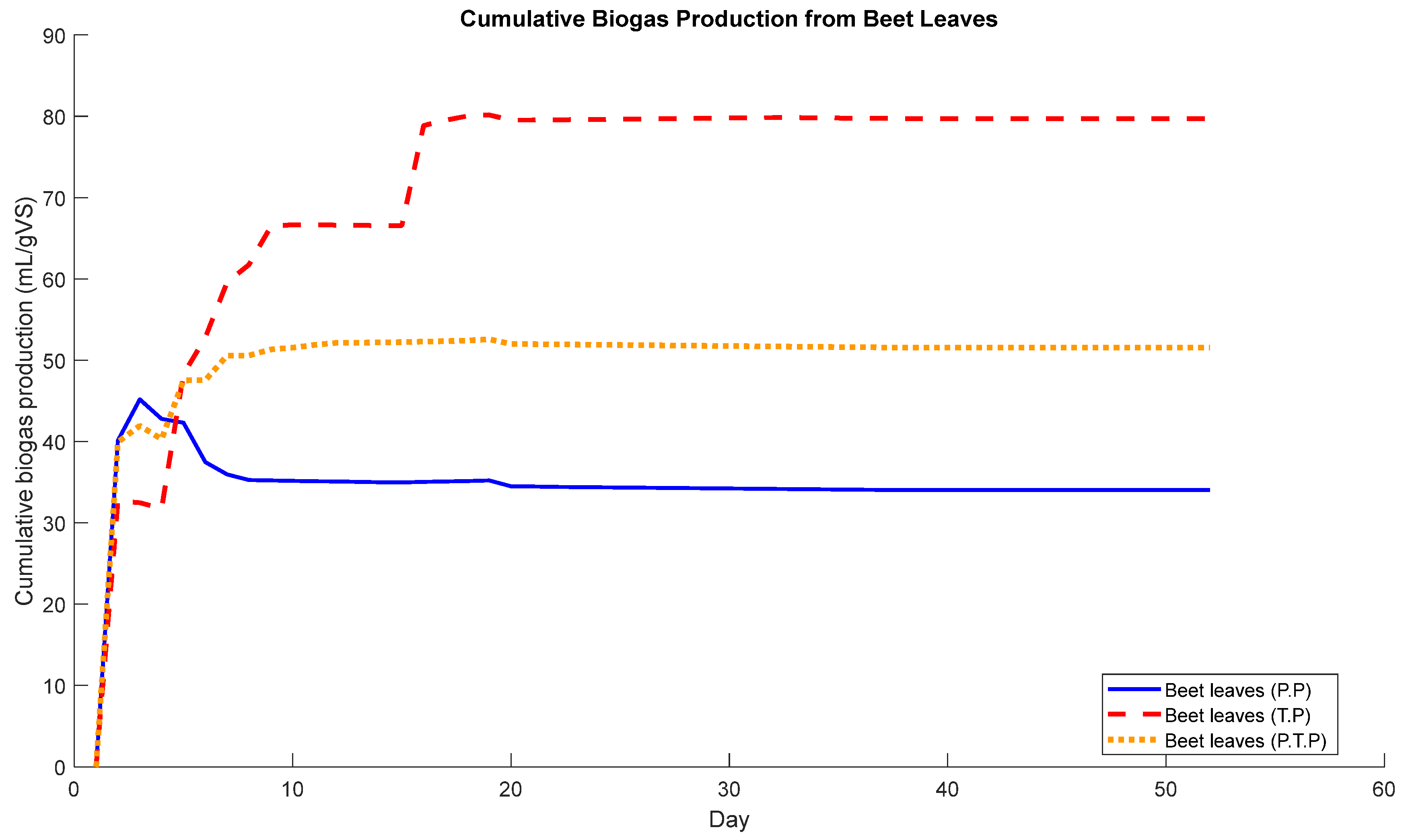
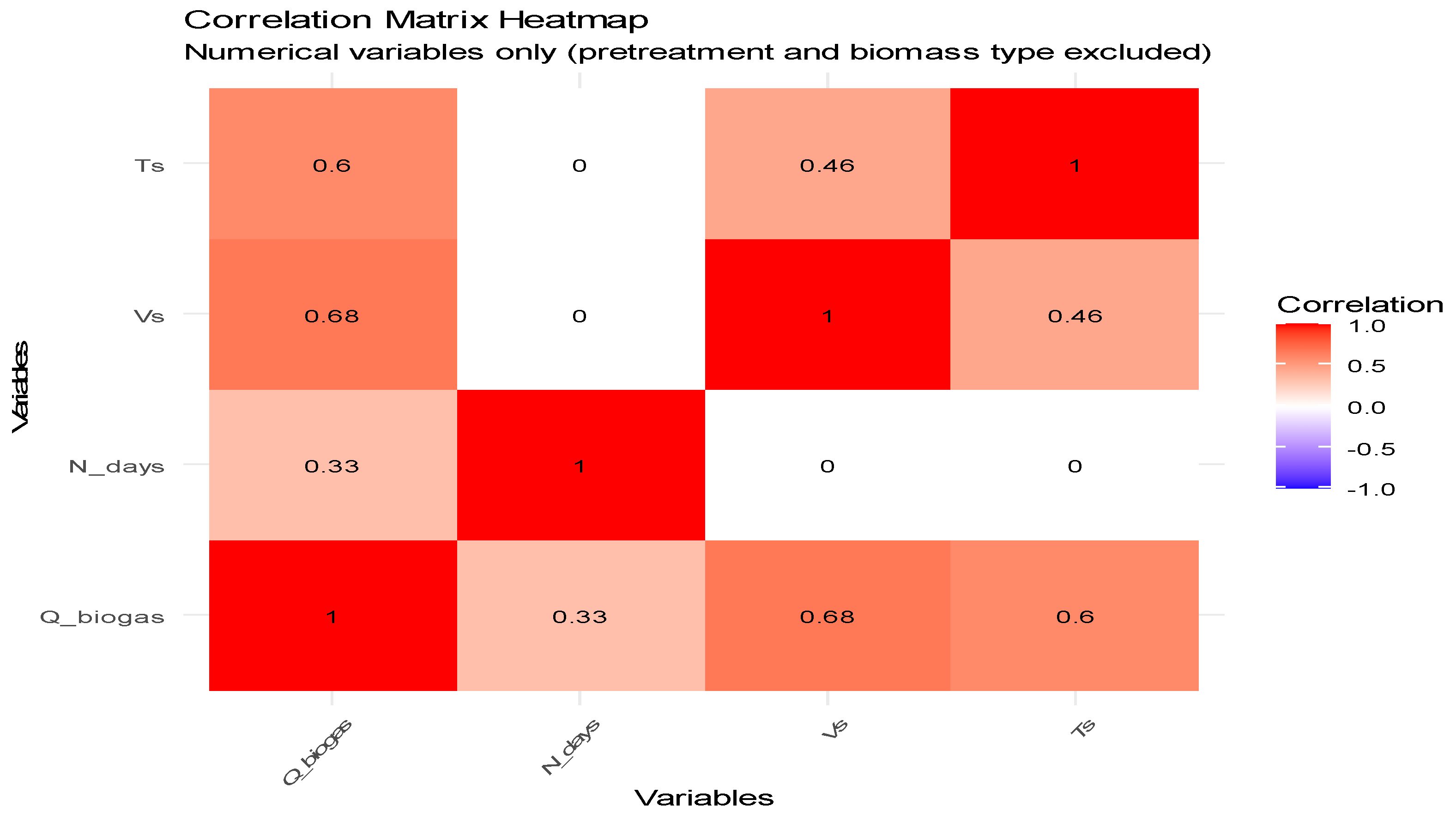

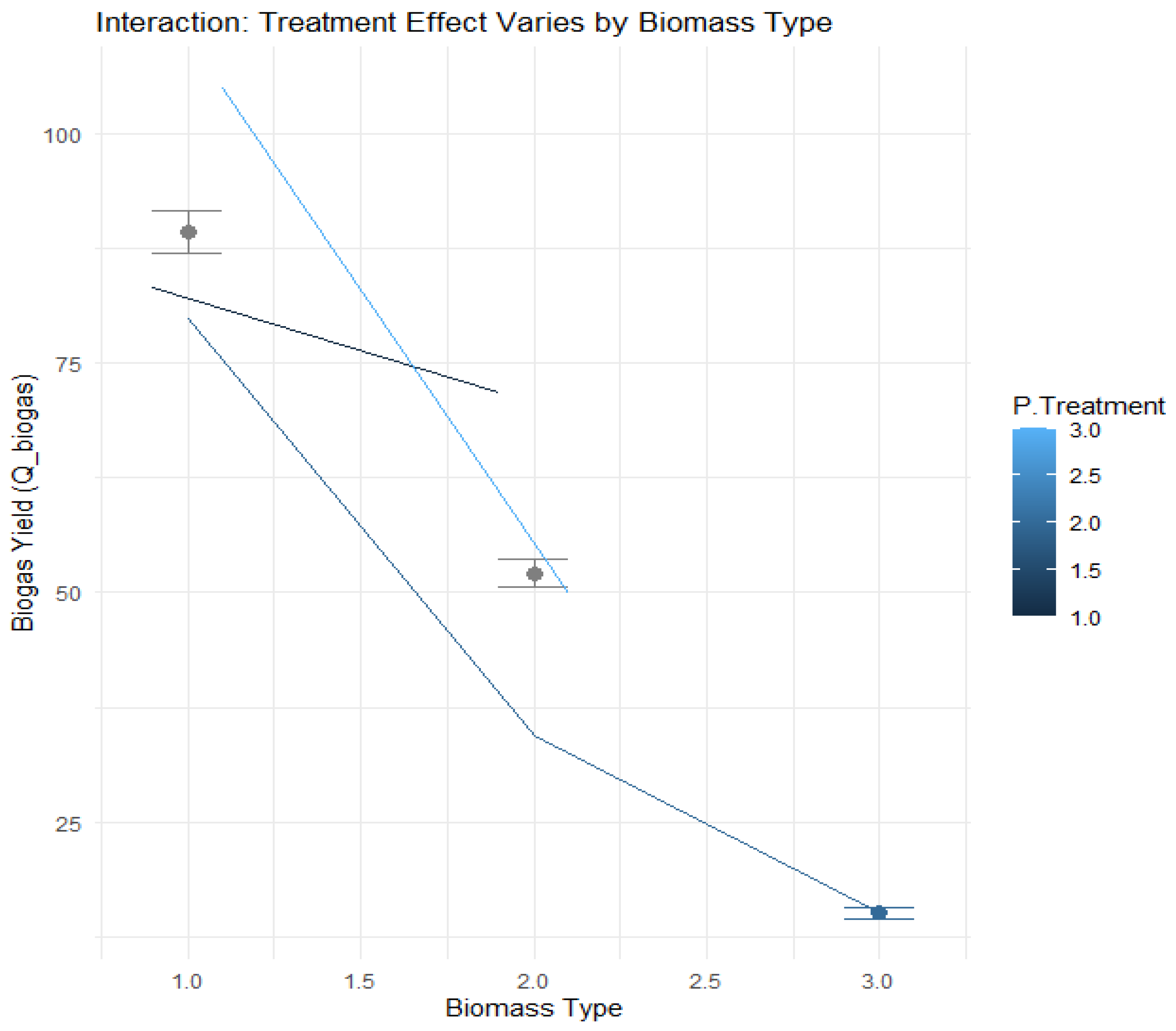
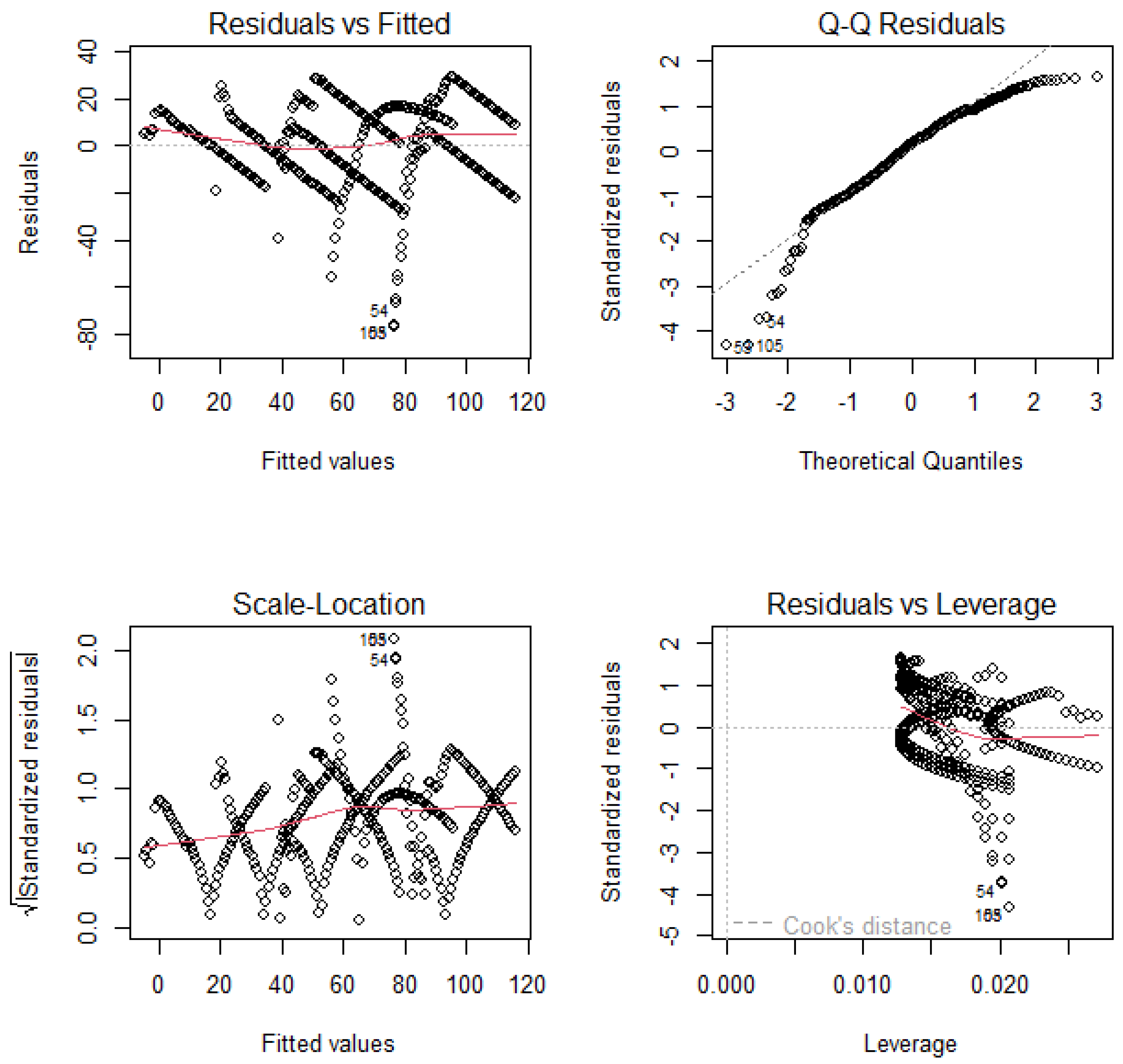
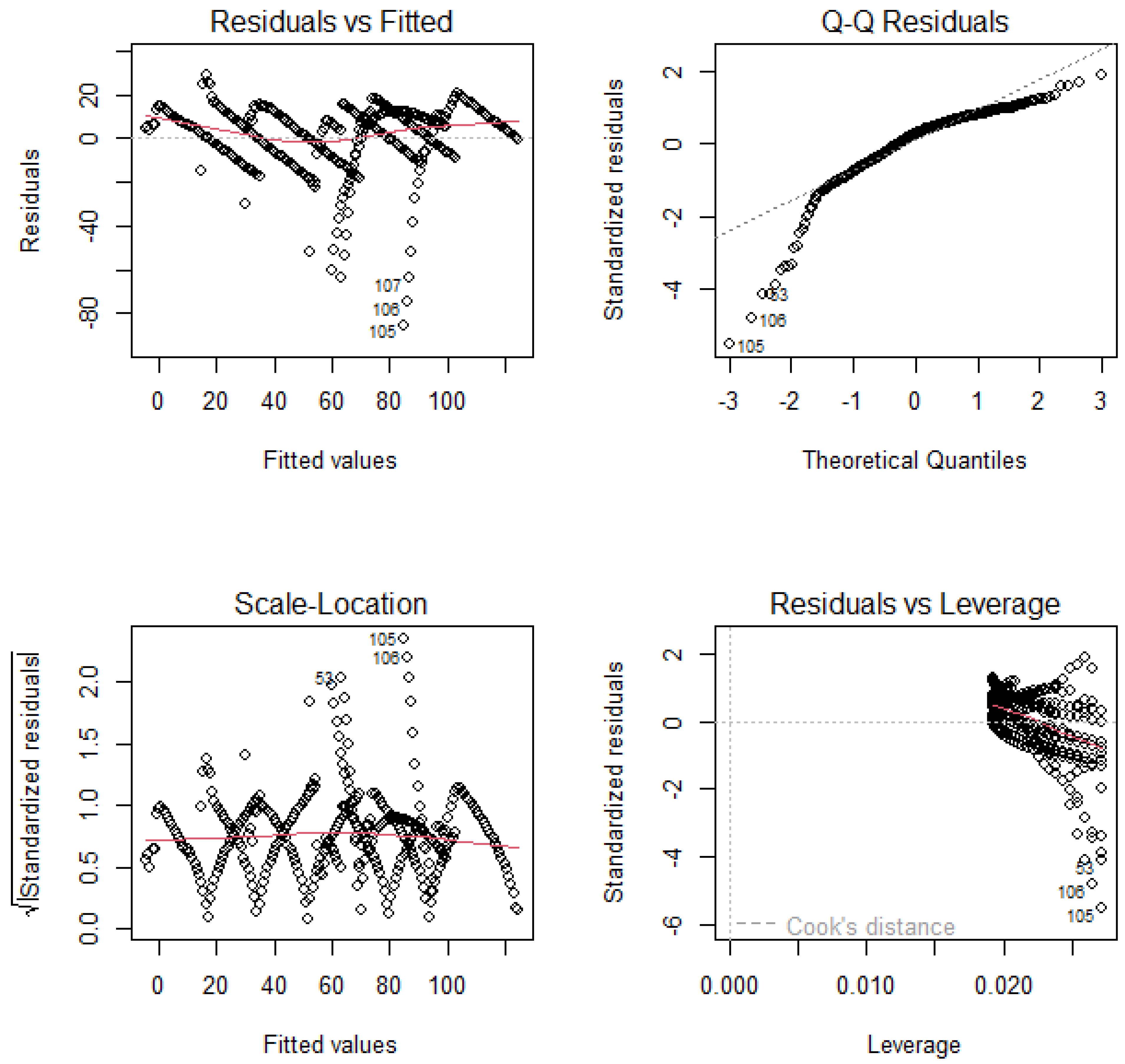

| Component Quantity (g) | Dry Matter (%) | Water (%) | Mineral Material (%) | Volatile Solids (%) | |
|---|---|---|---|---|---|
| Sheep feces | 1192.85 | 52.47% | 47.52% | 2.10% | 50.37% |
| Inoculum | 6400 | 7.05% | 92.89% | 1.80% | 5.25% |
| Beet waste | 7601 | 92.07% | 7.93% | 0.75% | 7.17% |
| Quantity of Biogas = β0 + β1 × Days + β2 × Pretreatment Type + β3 × Biomass Type + ε In this regression model without interaction terms, the quantity of biogas is the response variable, predicted by three explanatory variables: days, pretreatment type, and biomass type. The coefficients β0 (the intercept), β1, β2, and β3 are to be estimated from the data. The term ε represents the random error component, which accounts for the variability in the biogas quantity that the model cannot explain. | |||||
| Estimate | Std. Error | t Value | Pr(>|t|) | ||
| Intercept | 76.40395 | 2.56901 | 29.741 | <2 × 10−16 | |
| N_days | 0.77276 | 0.06228 | 12.407 | <2 × 10−16 | |
| df$TreatmentPhysical | −20.34310 | 2.47310 | 8.226 | 3.63 × 10−16 | |
| df$TreatmentBoth | −0.10090 | 2.47310 | −0.041 | 0.967 | |
| df$Type_biomass2 | −37.21731 | 2.01928 | −18.431 | <2 × 10−16 | |
| df$Type_biomass3 | −60.64288 | 3.19276 | −18.994 | <2 × 10−16 | |
| Multiple R-squared | 0.7395 | Adjusted R-squared | 0.7358 | ||
| F-statistic | 203.2 on 5 and 358 DF | p-value | <2.2 × 10−16 | ||
| Quantity of Biogas = β0 + β1 × Days + β2 × Treatment_Physical + β3 × Treatment_Both + β4 × Type_biomass2 + β5 × Type_biomass3 + β6 × (Treatment_Physical × Type_biomass2) + β7 × (Treatment_Both × Type_biomass2) + ε In this regression model with interaction terms, the quantity of biogas is the response variable, predicted by days, treatment type, and biomass type, along with interactions between specific treatments and biomass types. The coefficients β0 (intercept), β1 (days), β2 (physical vs. reference treatment), β3 (both vs. reference treatment), β4 (Biomass2 vs. Biomass1), β5 (Biomass3 vs. Biomass1), β6 (interaction: physical × Biomass2), and β7 (interaction: both × Biomass2) are to be estimated from the data. The term ε represents the random error component, accounting for unexplained variability in biogas quantity. The interaction terms (β6, β7) capture how the effect of treatment differs depending on the biomass type. | |||||
| Estimate | Std. Error | t value | Pr(>|t|) | ||
| Intercept | 63.47977 | 2.57074 | 24.693 | <2 × 10−16 | |
| N_days | 0.77276 | 0.05448 | 14.185 | <2 × 10−16 | |
| df$TreatmentPhysical | −3.34162 | 3.05911 | −1.092 | 0.275418 | |
| df$TreatmentBoth | 21.67016 | 3.05911 | 7.084 | 7.55 × 10−12 | |
| df$Type_biomass2 | −11.36895 | 3.05911 | −3.716 | 0.000235 | |
| df$Type_biomass3 | −64.72018 | 3.05911 | −21.157 | <2 × 10−16 | |
| df$TreatmentPhysical:df $Type_biomass2 | −34.00295 | 4.32624 | −7.860 | 4.62 × 10−14 | |
| df$TreatmentBoth:df$Ty pe_biomass2 | −43.54212 | 4.32624 | −10.065 | <2 × 10−16 | |
| Multiple R-squared | 0.8018 | Adjusted R-squared | 0.7979 | ||
| F-statistic | 205.7 on 7 and 356 DF | p-value | <2.2 × 10−16 | ||
| LM | RFR | GBM | |
| RMSE | 17.68617 | 14.75148 | 5.048408 |
Disclaimer/Publisher’s Note: The statements, opinions and data contained in all publications are solely those of the individual author(s) and contributor(s) and not of MDPI and/or the editor(s). MDPI and/or the editor(s) disclaim responsibility for any injury to people or property resulting from any ideas, methods, instructions or products referred to in the content. |
© 2025 by the authors. Licensee MDPI, Basel, Switzerland. This article is an open access article distributed under the terms and conditions of the Creative Commons Attribution (CC BY) license (https://creativecommons.org/licenses/by/4.0/).
Share and Cite
Rouegui, M.; Bellabair, H.; El Asli, A.; Amar, A.; Zoerner, W.; Rachidi, F.; Lghoul, R. Bio-Methanization of Sheep Manure and Beet Waste in the Meknes–Fès Region, Morocco: Effects of Pretreatment and Machine Learning Applications for Biochemical Methane Potential Prediction. Recycling 2025, 10, 213. https://doi.org/10.3390/recycling10060213
Rouegui M, Bellabair H, El Asli A, Amar A, Zoerner W, Rachidi F, Lghoul R. Bio-Methanization of Sheep Manure and Beet Waste in the Meknes–Fès Region, Morocco: Effects of Pretreatment and Machine Learning Applications for Biochemical Methane Potential Prediction. Recycling. 2025; 10(6):213. https://doi.org/10.3390/recycling10060213
Chicago/Turabian StyleRouegui, Meryem, Hind Bellabair, Abdelghani El Asli, Amine Amar, Wilfried Zoerner, Fouad Rachidi, and Rachid Lghoul. 2025. "Bio-Methanization of Sheep Manure and Beet Waste in the Meknes–Fès Region, Morocco: Effects of Pretreatment and Machine Learning Applications for Biochemical Methane Potential Prediction" Recycling 10, no. 6: 213. https://doi.org/10.3390/recycling10060213
APA StyleRouegui, M., Bellabair, H., El Asli, A., Amar, A., Zoerner, W., Rachidi, F., & Lghoul, R. (2025). Bio-Methanization of Sheep Manure and Beet Waste in the Meknes–Fès Region, Morocco: Effects of Pretreatment and Machine Learning Applications for Biochemical Methane Potential Prediction. Recycling, 10(6), 213. https://doi.org/10.3390/recycling10060213







